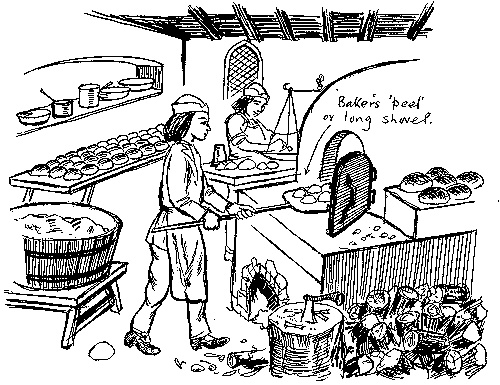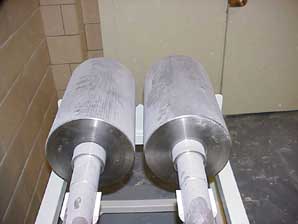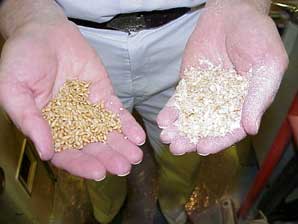The History of Bread
page 4
The Romans enjoyed several kinds of bread,
The stone-age man's method of pounding wheat between two stones
was not basically very different from the, method of grinding by
millstones in a wind or watermill. In either case the bottom stone
was fixed, and a grinding movement by the top stone was the required
action to produce ground meal. The stones were round, the bottom one
fixed, and the top stone, or runner, was balanced on a spindle which
could be raised or lowered, making the space between it and the
bottom stone as narrow or as wide as the miller wanted. Both stones
were corrugated, so that when the top stone was running, the wheat
between it and the bed was scraped rather than bruised. The wheat to
be ground entered the mill by a hole in the top stone, and was
carried out towards the edge, leaving in the form of a meal by holes
round the outside of the bed. By raising or lowering the top stone,
the meal could be made as fine or as coarse as required.
To obtain white flour from this meal, it was sifted through sieves
of different mesh; the finest sieve made of very strong silk.
Nowadays in America stone mills are of course not used much for flour-
making; only a few are still used for wholemeal flour and specialty
millers.
|
 An old English Bakery
An old English Bakery |
Watermills for grinding flour were of two varieties; in the first
kind the wheel turned horizontally in the stream, its shaft turning
the millstone directly, without any gears. The second type had its
wheel standing upright and the shaft at right angles to the stones,
moving them by means of a system of cogs.
The windmill made its appearance at the end of the twelfth century;
as it depended for its working on the amount of wind available, it
was not by any means an efficient machine. For over 700 years these
attractive buildings with their long sails were used for grinding
corn for people and for cattle-feed. There are still one or two of
them preserved in various parts of our country.
The plant of a modern flour mill has four main functions which are to
store a reserve of wheat, to remove all the impurities from the wheat
and prepare it for milling, to mill the wheat and separate flour from
the bran and skins of the wheat, and to store the milled products
before shipping.
You have no doubt seen the wheat stores or silos at a flourmill.
They are tall buildings housing a number of large cylindrical bins.
They are 60 to 90 feet high and may each hold 1,000 tons of grain.
The silo is equipped with mechanical elevators for dealing with
wheat, which invariably arrives, by road to the mill. It is also
equipped to weigh the wheat, to clean it of impurities, dry it to a
safe moisture-content before storage.
|
| The cleaning section or screen room draws wheat from the silo. Here
wheat is first cleaned on sieves, which removes all the impurities
different in size from the wheat grain. Magnets next remove any
fragments of iron or steel. Further equipment then takes out
impurities similar in size but different in shape from the wheat
grain, such as foreign cereals or round seeds. In the mill, the grain
passes through more than forty processes before it emerges as flour
and bran.
At the first stage of the milling process, the clean blended wheat
passes between chilled iron rolls, which revolve rapidly, one roll
faster than the other. These first sets of rolls (known as the break
rolls) have ridges or "flutes" on them. The slower moving roll tends
to hold the wheat while the faster one strikes the grain as it passes
between them. They are set very delicately, so that as the wheat
passes between them, they do not crush it, but shear it open in order
to make the inner white floury portions of the wheat come away from
their brown outer skins. If the wheat were merely crushed, the brown
skins would break up into countless tiny fragments, and would mix
with the white portions so thoroughly, and so finely, that they could
never be separated properly. These skins would then discolor the
flour badly and also spoil its baking qualities.
Some of the white floury portions will have broken away cleanly from their brown outer skins, but other white portions will still have pieces of skin fastened firmly to them. Therefore the materials from the break rolls must be sorted out. The pieces of brown skin must be separated from the white portions, and some of the material must be sent back to the fluted rolls for further separation. Mainly sifting the mixture does this sorting out of particles from the 'break' rolls; elevators first move the mixture to the top of the mill. There are several different types of sieving machine but usually only two kinds are used at this stage: first the 'plansifter' and then the 'purifier'. This is how they work. |
 |
Rollers used to grind the flour kernels
|
 wheat after the first run through the rollers wheat after the first run through the rollers
http://www.oznet.ksu.edu/aawf/July/july_5.htm |
|
Plansifters on Sifter Floor The plansifter is an arrangement of
about a dozen large sieves, one below the other-just like the floors
of a tall building. The top sieve has the coarsest mesh, the next not
quite so coarse, and so on. These sieves are all made to swing
briskly by machinery. The broken wheat comes first onto the top
sieve, and then through the others in turn, each sieves helping to
separate the material. The first sieves remove the bran skins, which,
because they still have flour particles adhering to them, are
returned to another milling machine for re-treatment. The finest
sieves are of silk, and these separate flour, which then starts on
its way to the flour-packing spout. The majority of particles are not
of bran, of course, but are at present too large for grinding down
into flour. They are known as semolina at this stage. They are taken
to the next sieving machines - the purifier.
The purifier is an ingenious machine that not only separates the
broken parts of the wheat by sieving, that is, according to size, but
it also separates those parts which are of the same size but of
|
| different weight. Using currents of air does this. The skins are much
lighter in weight than the inner white floury parts, and a current of
air is drawn upwards through the mixture on the sieve, lifting up
and 'floating' the skins, but allowing the heavier white parts to
remain on the sieve and be separated by the sieving motion. Sieving
on the plansifters and purifiers will eventually have removed most of
the brown skins. Now the inner floury portions of the broken wheat
grains are brought together for final milling between the 'reduction'
rolls.
These are smooth rolls that mill down very gradually and
accurately the inner white portions of the wheat (the endosperm or
semolina) into smooth, powdery, 'lively' flour. Thus flour, clean
bran and wheat feed are collected, each in its own channel, from a
large number of different machines and are finally brought either to
bulk storage bins or to a packing floor where they are filled into
sacks and weighed. Lastly, the packed products are sent to the mill warehouse and stacked ready for shipment. However, around 70% of the flour is shipped in bulk. The whole process of cleaning, and milling, etc., is
done by machine, with the material passing automatically from machine
to machine, and from one stage to the next. No hand touches the wheat
from the moment it arrives, throughout its long journey in the mill,
until the flour leaves the mill for the baker, biscuit-maker and
other users.
|
Today the range of flours available is wider than ever before. Each
type of flour has been milled with specific uses in mind. Flours
vary in their composition and, broadly speaking, are defined by their
rate of extraction. This refers to the percentage of whole cleaned
wheat grain that is present in the flour. The three basic flour
categories are Wholemeal -100 percent extraction, made from the whole
grain wheat with nothing added or taken away. Brown -usually contains
about 85 per cent of the original grain; some bran and germ have been
removed. This flour is frequently labeled as "85 per cent flour"
rather than brown. White -usually 75 per cent of the wheatgrain. Most of the bran and wheatgerm have been removed during milling.
Other varieties of flour:Wheatgerm -white or brown flour with at least 10% added wheatgerm. Malted wheatgrain -brown or wholemeal flour with added malted grains. Stoneground -wholemeal flour ground in traditional way between two stones. Organic -flour milled from wheat grown and processed naturally without the use of chemicals.
Bread in this country has to everybody's benefit reached a high
standard of purity and hygiene. Bread is perhaps the most important
item in our diet; it has often been called the staff of life. To give
you an idea of the benefit we get from flour and bread, a Government
survey showed that flour and bread provided us with more energy
value, more protein, more iron, more nicotinic acid and more vitamin
B1 than any other basic food. Bread comes to us in many interesting
shapes and Flavors, from the time-honored 'cottage' loaf, to some of the
delicious Vienna rolls. Nowadays, the sliced and wrapped loaf is the
most popular loaf of all. It is ideal for making sandwiches for
picnics, and for workers' lunches; there is, however, an important
drawback. If you like your bread with a beautiful rich golden crust
on it, do not buy the ready-wrapped variety.
One of the nicest things in life is to come home hungry from school or work, and have set before one the fresh, buttered crust from a well done home made loaf.
|
Page 1 Page 2 Page 3
Links
Kansas State University Research and Extension
Freshloaf an Old Fashioned Bakery
The Story behind a loaf of Bread
Minnesota Historical Society
|
|
|



 wheat after the first run through the rollers
wheat after the first run through the rollers 